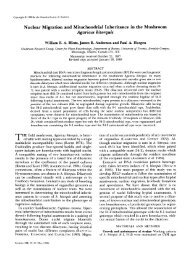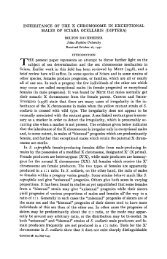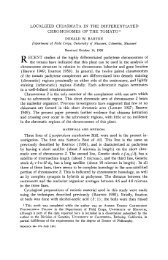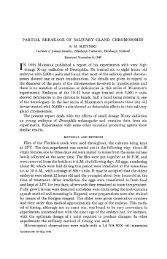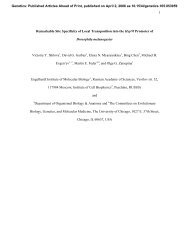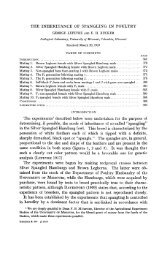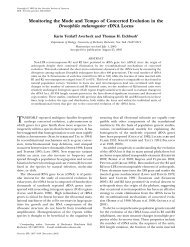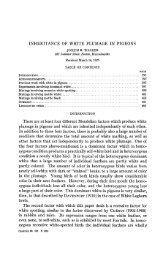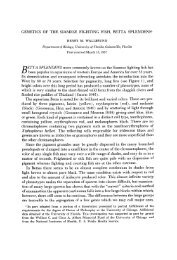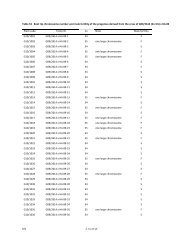abstracts of papers presented at the 1962 meetings - Genetics
abstracts of papers presented at the 1962 meetings - Genetics
abstracts of papers presented at the 1962 meetings - Genetics
Create successful ePaper yourself
Turn your PDF publications into a flip-book with our unique Google optimized e-Paper software.
994 ABSTRACTS<br />
mouse typhoid than <strong>the</strong> outbred T. (Work supported by U. S. Public Health Service Research<br />
Training Grant 2G-246.)<br />
WIJEWANTHA, RONALD T., and G. LEDYARD STEBBINS, University <strong>of</strong> California, Davis, California.:<br />
Developmental genetics <strong>of</strong> <strong>the</strong> agropyroides mutant in barley.-A mutant affecting spike<br />
morphology was recovered from a dalapon tre<strong>at</strong>ed field <strong>of</strong> six-rowed barley, variety California<br />
mariout. F, progeny from reciprocal crosses showed single factor inheritance with <strong>the</strong> mutant<br />
behaving as a recessive.-The upper parts <strong>of</strong> mutant spikes bear nodes with a single spikelet and<br />
with <strong>the</strong> glumes placed l<strong>at</strong>erally r<strong>at</strong>her than dorsally. This produces a morphological resemblance<br />
to Agropyron (or Triticum). The name Agropyroides, and <strong>the</strong> gene symbols ag ag, are <strong>the</strong>refore<br />
suggested for this mutant.-Agropyroides homozygotes show 100% penetrance and variable<br />
expressivity. The ug gene inhibits development <strong>of</strong> l<strong>at</strong>eral spikelet components during early differenti<strong>at</strong>ion.<br />
At comparable nodes on a developing spike, <strong>the</strong> central spikelet primordium grows<br />
much faster than th<strong>at</strong> <strong>of</strong> <strong>the</strong> l<strong>at</strong>eral spikelet, <strong>the</strong> growth r<strong>at</strong>io being 13:2, as compared to 7:2<br />
for normal spikes.-When crossed reciprocally to <strong>the</strong> two-rowed barley variety, Atlas deficiens,<br />
agropyroides, showed a modified dihybrid segreg<strong>at</strong>ion in <strong>the</strong> F,, since two-rowed is incompletely<br />
dominant over six-rowed.-On a six-rowed background, ag decreases <strong>the</strong> number <strong>of</strong> spikelets per<br />
node in <strong>the</strong> upper half <strong>of</strong> <strong>the</strong> spike, but on a two-rowed deficiens background <strong>the</strong> opposite effect,<br />
increase in spikelet number, is produced <strong>at</strong> some <strong>of</strong> <strong>the</strong>se nodes.<br />
WOLFF, G. L., The Institute for Cancer Research, Philadelphia, Pa.: Body and tail length<br />
differences between yellow (A’a) and nonyellow (aa) mice in parabiosis.-The existence <strong>of</strong><br />
hormonal differences between (AYa) and nonyellow(aa) mice has long been suspected. If such<br />
differences exist, <strong>the</strong>y might be detectable in parabionts. Inbred yellow and nonyellow mice from<br />
<strong>the</strong> YS/ChWf strain were joined parabiotically <strong>at</strong> four weeks <strong>of</strong> age with litterm<strong>at</strong>es <strong>of</strong> <strong>the</strong><br />
same sex in three combin<strong>at</strong>ions: AYa:AYa, AYa:aa, aa:aa.-By 27-31 weeks <strong>of</strong> age <strong>the</strong> bodies,<br />
exclusive <strong>of</strong> <strong>the</strong> tails, <strong>of</strong> <strong>the</strong> yellow mice were longer (P





